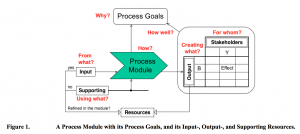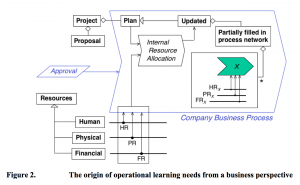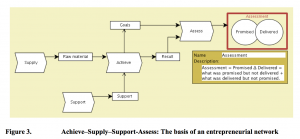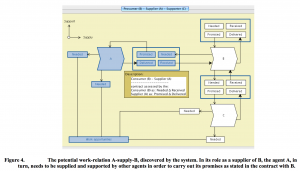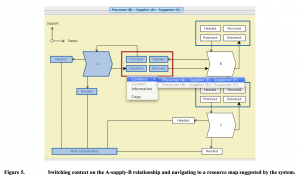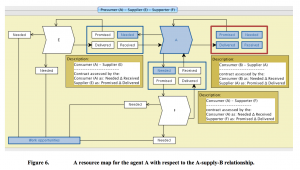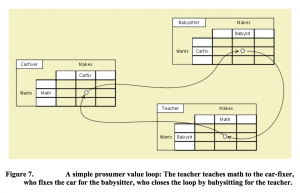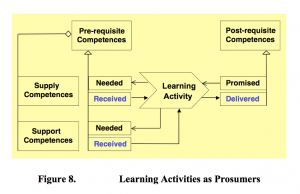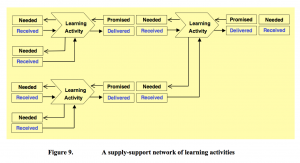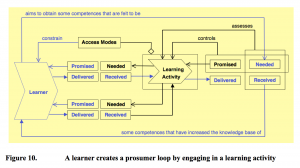Opportunistic (L)earning in the mobile knowledge society by Ambjörn Naeve, 2010.
///////
This page is a sub-page of our page on Business Algebra.
///////
Related KMR-pages:
• …
///////
Other relevant sources of information:
• …
///////
Abstract:
This paper discusses the concept of opportunistic collaboration within the emerging mobile knowledge society and how such unplanned collaboration is promoted by several social and technological changes. The paper illustrates how opportunistic collaboration can be applied to the areas of learning and earning by demonstrating how to transform a traditional unemployment agency into an Opportunistic Collaboration Agency based on an entrepreneurial supply-support network structured in the form of a prosumer manifold.
The OCA pattern provides ways to:
(i) capture the dynamics of entrepreneurial work-relations in the emerging “work-portfolio society,”
(ii) increase the transparency of the entire value chain of economic activities, and
(iii) create prosumer value loops that can support multi-dimensional bartering and increase the opportunities for marginalized groups of people to create value together.
The paper ends by demonstrating how to use the OCA pattern to transform a traditional educational institution into an opportunistic learning activity broker (called EDUHAIQ) that could help to bridge the gap between formal and informal learning.
1. Introduction and background
This paper deals with opportunistic collaboration within the context of learning and earning, which are increasingly important and interconnected activities in modern life. Unplanned opportunities for collaboration arise naturally in our present mobile knowledge society, where increasing mobility brings both people and ideas into contact faster than ever before. In this context, ‘mobile knowledge’ has at least two different meanings: (i) knowledge that moves (= disseminates), and (ii) knowledge that is created and communicated by mobile agents. In the mobile knowledge society, knowledge is disseminated at an ever-increasing rate, and more and more mobile knowledge agents are coming into play.
The effects on learning, introduced by this type of mobility, is a matter of intense research. The approach of the London Mobile Learning Group (Pachler, 2009) is based on a mobile complex that operates within a socio-cultural ecology. This ecology consists of agents, who interact with each other within different structures, and who behave according to various cultural practices (Pachler et al., 2009). Learning is viewed as culturally situated meaning-making, where each learner forms her own personal learning habitus, largely driven by the normalization of mobile devices in everyday life.
A key aspect of the socio-cultural ecological approach to education (Pachler, 2009) is the increasing individualization of risk-taking. In education, the responsibility for meaning-making is being transferred from the state to the individual, which is reflected in the shift in educational rhetoric from ‘teaching’ to ‘learning.’ It is also related to the ongoing fragmentation of mass communication, driven by the emergence of social media. A key aspect of the mobile complex is the increasing interrelation of Internet services with user activities around mobile devise use. All these characteristics of mobile learning promote opportunistic collaboration in a multitude of different ways (Bruns, 2009b). In fact, young people constantly make use of social media on mobile devices to collaborate opportunistically. “Who will join whom at what party” is an example of a frequently recurring problem domain for such collaborations.
The advantages of the opportunistic collaboration patterns that are made possible by using mobile devices in social interactions are being exploited in many different ways. Calling your wife on her way home from work and asking her to pick up something that you suddenly found missing for your dinner cooking is a familiar example from family life. Within traditional (= broadcast-oriented) media, many big news sites (such as e.g., CNNiReport) have areas where anyone can upload material that could be interesting for the “news makers” to broadcast.
The big news networks know that they cannot control who will be standing next to an interesting news item of today – with access to a camera to document it. They also know that the number of potential eyewitnesses with documenting capabilities has increased beyond the wildest expectations of anyone from 20 years ago, and today covers almost half the population on this planet. This type of spontaneous “media swarming” is well known (and often feared) by all celebrities who are monitored by our present “mobile-little-brother society”. Whenever a celebrity shows herself in public, little brother sees her and immediately uploads the documentation to prove it. This type of opportunistic media swarming is also justly feared by politicians that have an opposition to oppress, which was recently demonstrated by the efficient use of Twitter in the orchestration of election protests in Iran.
Another interesting example involving a synchronous form of opportunistic collaboration is CITIHAIQ, a system for opportunistic car-ride sharing that is being developed in Sweden, and which is planned to be launched during 2010. By sending an SMS to a server, a person can announce that she is going to drive from A to B and that she is willing to take passengers. At the same time other persons can inform the server that they are looking for a ride from C to D. Based on location information and declared intentions, the server can then figure out opportunistic matches between the set of drivers and the set of potential passengers – and inform the corresponding people about suitable meeting points to take advantage of the ride-sharing opportunities that happen to be available.
Synchronous communication depends on finding a time slot “that works” for everybody. In our time-poor ‘busyness’-driven society, where we increasingly find ourselves involved in mobile and multi-tasking activities there is a shift in emphasis of communication modes. We are decreasing our dependence on synchronous communication modes (such as face-to-face meetings, or telephone conferences) and becoming increasingly dependent on more asynchronous modes (such as e-mail, Twitter, Facebook, …). Moreover, an increasing number of synchronous events are being recorded in a media-rich way and made available for asynchronous access whenever the interested viewer/listener has some time to spare. This trend is clearly visible in mainstream media, with the launching of a large number of media websites that provide asynchronous access to their already broadcasted programs.
According to Pachler (2009), “mobile devices have the potential to move the learning experience from the artificial confines of the classroom and out to more naturalistic field settings.” This puts tremendous stress on the traditional curriculum-based educational system, which is almost totally based on laying a planned path into the future. It is a major challenge to integrate the planned collaborative structures of traditional education with the new “mobile opportunities” (for both planned and unplanned collaboration) in a way that can increase the interest and motivation of young learners to tackle intellectually challenging material. As described by Pachler (2009):
/////// Quoting Pachler (2009): We are concerned about the dangers of a failure of the education system to keep pace with the developments around meaning-making in the context of media use in the life-worlds of young people and society more widely and argue the need for a purposeful ‘push’ in approaches to mobile learning in all sectors of education in order to avoid a potential disconnection between the way young people operate in their everyday lives and the way educational institutions interact with them.
/////// End of Quote from Pachler (2009)
In his excellent and thought-provoking book The Age of Unreason, Charles Handy (1989) shows how the same underlying pattern is applicable to our work life in general. In work – as well as in education – there is a shift from planned to unplanned collaboration. We are used to thinking of work in terms of life-long employment, climbing up a highly visible and desirable ladder of professional promotions. This planned-carrier work has traditionally been carried out in terms of meticulously planned collaboration between employers and employees, within the legal framework of stable companies.
Over the last few centuries, corporations have been allowed to grow into organizations of unprecedented power. This has been accepted by society largely because, as employers, the big corporations have been able to provide jobs for large parts of the population. In fact, this provision has been a fundamental part of the social contract. However, in the ‘knowledge economy’ of today, this contract has been thoroughly revised. The ‘labor market’ has changed, and the traditional work-relations have been fundamentally transformed. In fact, our work-life is starting more and more to resemble what Handy (1989) calls a work portfolio. This can be seen in many ways, from the increased official worshipping of the ‘entrepreneurial spirit’ to the spectacular rise of a plethora of different ‘staffing companies’ that can deliver the type of employees-on-demand that an increasing number of employers seem to prefer.
In this paper I aim to show how we can make use of the Knowledge Manifold information architecture to support opportunistic collaboration – both in work processes and within educational systems. As an example, I will illustrate how we could transform a traditional Unemployment Agency into an Opportunistic Collaboration Agency that can support people to explore, capture and realize their collaborative potential – especially people that are finding it increasingly difficult to “find a job” within the traditional labor market. Moreover, I will also discuss how to apply the OCA pattern to open up dynamic allocation to education for non-traditional groups of learners.
The OCA pattern reflects a strategic shift in the way we manage our work distribution processes, a shift that is already going on in society. Just as we must harness the power of mobile devices for learning, we must harness the power of the Internet for creating portfolios of (work) opportunities for people (Handy, 1989). It is no coincidence that dating services are among the most popular services on the net. Professional group dating services is what an OCA can and should provide.
If we fail in supporting this strategic shift, we risk creating a disconnection that is analogous to the one that is described by Pachler (2009) and cited above. In this case it is a disconnection between the way our work-life actually functions, and the way that we organize ourselves around and within it – a disconnection that will make us miss many opportunities to work and create value together.
In this paper I will also try to show how opportunistic collaboration is facilitated by opportunistic annotation techniques within what Nilsson et al. (2002) call the metadata ecosystem. A good metadata ecosystem should support opportunistic interaction between independently evolving threads of discourse. This is hugely facilitated if the following two conditions are satisfied: (i) the descriptions are semantically open (in the sense that they allow unknown tags), and (ii) change-by-increment can be applied to the evolving descriptions.
In opportunistic collaboration, the major collaborative commitments are made at run time, as opposed to what happens in planned collaboration where these commitments are made at compile time. Therefore, enabling and supporting OC means that we should create systems and services that make it possible for people to collaborate in unexpected and unplanned (ad-hoc) ways. As pointed out by many researchers, such as e.g., Handy (1989), and Gorelick et al (2004), the rigidity of traditional organizations makes them less and less able to respond properly to many of the challenges that face us today. Senge (1990, 2006) emphasizes the need for organizations to become learning organizations, that can apply what Argyris and Schön (1978) call double-loop learning, in order to change their mental models, i.e., their ingrained ways of thinking about what they do and why they do it. According to these organizational researchers, successful organizations are busy with flattening their organizational hierarchies and introducing more process-oriented and opportunistic ways of working together.
In education, opportunistic collaboration is a strong trend that is reflected in a shift of focus from teaching to learning within a social context. Life-long, flexible, collaborative, and personalized learning are words that are increasingly used in places where education is discussed and designed. They express important wishes that imply new demands on learning architectures, with regard to pedagogy, organization and technology.
The traditional educational architectures are based on teacher-centric, curriculum-oriented, knowledge-push. The new demands are largely concerned with a shift along all of these dimensions in order to support more learner-centric, interest-oriented, and knowledge-pulling types of learning architectures (Naeve, 2001a,b, 2005). At the same time, within most organizations, new demands are being placed on effective knowledge management. Promoting the creation and sharing of knowledge in order to assure the right person with the right knowledge in the right place at the right time at the right cost is the overall aim of these demands. In the (present) words of Wikipedia:
/////// Quoting Wikipedia: Opportunistic collaboration is emerging in knowledge organizations. As Chatzkel (2003) asserted, a knowledge organization “needs to nurture its people so that they feel free to move about in their organization, to group and regroup in different configurations as needed, and to rework themselves and their resources in concert with their new conditions.” (p. 20) It is a promising direction to explore this design in educational contexts. A recent study (Zhang et al., 2006) indicated that the opportunistic collaboration model led to a high level of collective responsibility, more pervasive, flexible, distributed collaborations, and greater diffusion of information and knowledge advances.
Due to the rise of social media, the traditional roles of producing and consuming ‘knowledge’ are increasingly challenged by knowledge ‘prosumers,’ people that simultaneously produce and consume knowledge. Peter Drucker has coined the term “knowledge workers” for such people. Taken together, these individuals and their organizations form the basis of what we call the “knowledge economy” or even the “knowledge society.” Today there is wide consensus among politicians and economists that developing and strengthening the knowledge economy should be the main strategy for the developed countries to maintain a competitive edge in the increasingly global economy.
/////// End of Quote from Wikipedia
In summary, I aim to show how a group of knowledge prosumers can act together within a knowledge manifold type of information architecture that could be called a prosumer manifold. The main argument of this paper is that such prosumer manifolds can enable and support opportunistic collaboration in a number of new and important ways.
2. The Knowledge Manifold: Content in Contexts through Concepts
The work within my research group is based on the fact that knowledge management ideas and Semantic Web technology can promote opportunistic collaboration by capturing essential knowledge, refining it through open dialog, and making it available within a global, asynchronous, public service system in the form of a web-based and globally accessible knowledge- and learning management environment (Naeve et al., 2005). Our way to orchestrate such a system is in the form of a knowledge manifold (Naeve, 2001a), an information architecture that will be briefly described below.
2.1. Overall architecture
When applied to education, a knowledge manifold is an open educational architecture based on learner-centric, interest-oriented “knowledge-pull,” which is designed to support inquiry-based and customizable forms of networked learning. A knowledge manifold consists of a number of linked information landscapes (contexts), where one can navigate, search for, annotate and present all kinds of electronically stored information. A KM is constructed by conceptual modeling of a specific knowledge domain in order to capture its underlying thought patterns in the form of context-maps. The KMR group makes use of the KM architecture to construct a form of conceptual web (Naeve 2005) which functions as a conceptual interface to the underlying (machine) semantic web.
A knowledge manifold has the following major characteristics:
• It can be regarded as a form of knowledge patchwork, with a number of linked knowledge patches, each with its own knowledge gardener.
• It gives the learners the opportunity to ask questions and search for live knowledge sources to discuss them with.
• It has access to distributed archives of resource components, which are described using standardized metadata annotations.
• It allows teachers and learners to construct customized learning modules by composing (aggregating) resource components.
• It makes use of conceptual modeling in order to construct context maps whose concepts (and concept relations) can be filled with content. This supports the separation of content from context and promotes the reuse of content across different contexts.
• It contains a concept browser, which is a type of knowledge management tool that lets the user construct and navigate the context maps and view their content.
The KM architecture is based on the following basic pedagogical principles:
• Nobody can teach you anything, but a good teacher can inspire you to learn.
• Your motivation to learn is based on your experience of subject exitement and faith in your learning capacity from live teachers.
• Your learning is enhanced when you take control of your own learning process.
• No ”problematic” questions can be answered in an automated way. It is only when your questions break the preprogrammed patterns that the deeper part of your learning process begins.
• Respect for ignorance, which is of fundamental importance in a non-elitist knowledge society, can only be upheld when the ignorant person is uneducated.
2.2. The concept browser Conzilla
Over the last decade, the KMR-group has developed a number of tools that support the collaborative construction and connection of content and contexts in the form of knowledge manifolds, notably the electronic portfolio system Confolio, and the concept browser Conzilla with its collaboration service Collaborilla. These tools are based on Semantic Web technology, which enables them to partake in the web of linked data that is emerging based on the vision of Tim Berners-Lee from 1998.
Conzilla (Naeve, 2001b; Palmér and Naeve, 2005) is a concept browser, or a conceptual web browser, which is designed to support the overview of complex information structures by enabling a multitude of different strategies for information hiding. Conzilla supports the construction, navigation, annotation, and presentation of the contexts, concepts and content stored in the form of a knowledge manifold. In fact, Conzilla presents content in contexts through concepts. A concept is regarded as the boundary between its inside, which contains its content, and its outsides, which represent the different contexts (maps) in which the concept appears. By right-clicking on a concept, one can navigate between all the different contexts where this concept appears. This type of contextual neighborhood navigation provides a very powerful way to cross reference information and browse through conceptual information landscapes.
Collaborilla (Ebner, et al, 2007) is a collaboration service within Conzilla, which enables the publication of different parts of collaboratively constructed context-maps from different sources. Collaborilla enables us to:
• reuse and extend contributions published by others.
• create new context-maps that include existing concepts and concept-relations from other publishers.
• add content to the contributions of others.
• add comments (metadata) on the contributions of others.
By using Conzilla / Collaborilla / Confolio, a knowledge manifold can be constructed in a collaborative fashion – reusing globally identifiable concepts across different contexts. Conzilla/Collaborilla can handle collaborative contexts, and Confolio can handle collaborative content. Both of these tools are designed to be connectable to mobile devices in various ways. Especially interesting in the short term is the scanning and uploading of information from mobile devices to Confolio. This will enable local communities to contribute information that can be collaboratively contextualized on the web. We believe that this type of interaction is a key aspect of a global asynchronous public service environment that can help to harness the power of opportunistic collaboration.
3. The Metadata Ecology
3.1. Contextual metadata and the dangers of standardization
In the ongoing paradigm-shift from knowledge push to knowledge pull (Naeve, 2005), an increasingly valuable type of “contextual metadata” on a resource is comments from users about what they thought of it’s value in various contexts – especially if this metadata can be made searchable. In 1988, when refusing to accept the Swedish Crawford medal, the French mathematician Alexander Grothendieck stated that “let my work be judged by its offspring and not by its offering.” This way of thinking about publication represents a paradigm shift away from the traditional closed publication systems towards towards open publications that offer searchable semantic links for comments (annotations). Semantic Web techniques makes it possible for a resource to have distributed metadata that can be aggregated and processed independently of where they are stored on the web. This type of resource-centric, contextualized metadata is the basis for the annotation techniques and tools that are developed by the KMR group. See (Palmér et al, 2004)
This is analogous to the change-by-increment principle that can be supported by a graph-centric view of looking at metadata. The reputation of a publication can be changed by somebody pointing to it and expressing her/his opinions about it. If this person has a high standing in the community and expresses the opinion that the publication represents a valuable contribution, then this publication will increase in importance (Korfiatis and Naeve, 2005). This is an important aspect of what is sometimes referred to as “the web of trust.”
In this type of environment, associating metadata with a resource becomes a never-ending annotation process, which creates a kind of metadata ecosystem (Nilsson et al, 2002), where the user feedback provides a selection pressure that supports the evolution of quality by highlighting resources of high quality. In this metadata ecosystem, every community of practice has its own specific description needs that should be possible to add on top of various standards. Therefore, what is needed is an open-ended description system that allows for new elements to be added without changing the old descriptions – but rather reusing the parts of the old descriptions that are still valid. In this way it becomes possible to apply the “change by increment” principle that has made object-oriented programming such an immense success. The technical infrastructure of the Semantic Web – RDF(S) – provides the basis for such a system. Just like an ordinary language, RDF(S) provides rules for HOW to express information, while leaving the user free to choose WHAT to express. Unfortunately, most metadata standards have focused on restricting WHAT to express, which has lead to increasing problems of interoperability.
3.2. Supporting and enhancing opportunistic collaboration
Semantic Web technologies enable a shift away from the traditional closed, document-centric, and text-based annotation techniques, and towards open, graph-centric, and unique-address-based approaches to handling discourses, i.e., recording, storing and retrieving them. This represents a real paradigm shift since it enables three important improvements: (i) an open descriptional system which allows unknown descriptional elements (tags), (ii) global distribution of metadata (annotations) about a resource, and (iii) a change-by-increment approach to resource descriptions. Taken together, these improvements increase the possibilities for opportunistic collaboration by making it easier to handle the description of evolving and interlinking web-based interactions.
(i) The underlying descriptive technology RDF(S) provides an open descriptional system, where an unexpected description tag, which is found at runtime does not crash the system. This is in contrast to the traditional, document-centric descriptive approaches, which lead to closed descriptional systems, where all allowed description tags must be declared at compile time.
(ii): The information about the information (metadata) can be as distributed as the information itself without losing track of what the information is referring to. This is because the metadata system allows the unique identification of the concepts and resources that are being described, as well as the description tags that are being used. Because of the unique identity (URI) of everything that is being described, on the Semantic Web anyone can state anything about anything in a way that is retrievable by machines. This allows our descriptional systems to be transformed from the traditional centralized opinion registration systems to distributed opinion publication systems. Hence the Semantic Web can support the assessment of a piece of information a posteriori (= by its offspring) instead of a priori (= by its offering).
(iii): Since the metadata is structured in the form of a graph and not in the form of a collection of documents, updating the descriptions can be performed by adding new nodes to the graph and pointing into the old parts (sub-graphs), which are still valid. This makes updating the information a lot easier and creates a new type of window of opportunity for opportunistic collaboration, by lowering the thresholds of the difficulties involved.
In summary, the metadata ecology (Nilsson et al, 2002) can be seen as a descriptional aspect of the socio-cultural ecology (Pachler, 2009), which can keep track of evolving and interlinked discourses and promote the judgement of their value a posteriori (by their offspring). This can be achieved because the metadata ecology has the following three important properties:
• It is semantically open-ended, i.e., it accepts unknown description tags without crashing.
• It supports unique identification of concepts (by the use of URIs for both described and describing entities.
• It allows incremental updating (change by increment) of all descriptions.
4. Modeling Networks of Collaborating Processes
4.1. The Astrakan™ Process Modeling Technique
In a service oriented environment aiming for reusability of service components, the “process-object” – or process-module” is of vital importance. In the Astrakan™ process modeling technique, which underlies the diagram of Figure 1, a Process Module has certain Process Goals, produces Output Resources for different Stakeholders, refines Input Resources and makes use of Supporting Resources. Moreover, the difference between an input- and a supporting resource is that the former is refined in the process, while the latter facilitates this refinement.
4.2. Operational learning needs from a business perspective
The learning processes in the workplace can be divided into operational and strategic, which reflects the two different levels on which a company operates. The operational level deals with the short range of everyday activities of the company, while the strategic level is concerned with the long-range development of its future activities. Operational learning needs are mainly project-based (“what do we need to learn in order to handle the project that just got approved”), while strategic learning needs are mainly competence-based (“what do we need to learn in order to secure the approval of future projects”). “Project-based” here is understood as “planned” activities, with schedules, clear objectives and milestones, as opposed to ad hoc reactions.
Figure 2 shows how the project-based operational learning needs arise in the workplace from a business perspective. As shown in this figure, the overall Company Business Process is supported by Human Resources (HR), Physical Resources (PR), and Financial Resources (FR). In order to attract business, the company is involved in a Project Proposal, which involves the construction of a Project Plan. When the project gets approved, which is modeled by the occurrence of an Approval event, this triggers an Internal Resource Allocation (IRA) process, resulting in an Updated Project Plan, which contains a Partially filled in process network. In this IRA process, the available supporting resources (HR, PR, FR) of the company are distributed across the various process modules that describe the workflow of the project, and a suitable part of these resources (HRX, PRX, FRX) are allocated to process module X. The learning needs arise from the “competence-gaps” in this process module network. These gaps are often differences between what a person actually knows and what s/he should have known (in order to be able to function in a position that was originally planned for someone else).
5. From Unemployment Agency to Opportunistic Collaboration Agency
The automating of work is one of the main drivers of unemployment, (the fear of) which in turn is one of the main drivers of life-long learning. The idea is that when we have been (or when we are threatened to be) replaced by a machine, we will be able to pick up new skills that make us ‘employable’ again, i.e., attractive in the “labor market.” Today, the traditional notion of long-term, steady work seems to have more or less disappeared, and has been substituted by the modern ideas of ‘flexibility’ and “temporary staffing.”
As described above, in these more and more rapidly changing times, many companies are discovering the value of opportunistic collaboration in more or less autonomous teams. In this section I will apply the same idea to a person – or a group of persons – that are unemployed or underemployed. How could he/she/it be given effective and efficient access to possibilities of opportunistic collaboration?
A group of collaborating agents can be organized into a supply-support network of entrepreneurial achievers that are assessed in terms of how well they deliver on their promises (see figures 3-6). I will refer to such an arrangement as an entrepreneurial network or an opportunistic collaboration network.
The achievers of an entrepreneurial network are assessed according to the symmetric difference between what they promise to deliver (at project-contract-time) and what they actually deliver (at project-run(out)-time):
Assess(Achiever) = Promised ∆ Delivered = what the Achiever promised but did not deliver, and
what the Achiever delivered but did not promise (to deliver).
The ideal value of this measure is the empty set. Then the achiever has delivered exactly what it promised – and nothing else. Of course, the ideal is to deliver what you promise, but sometimes this turns out to be impossible because you did not receive the things that you needed in terms of supply and/or support. This situation is discussed in section 5.2 below.
5.1. The OCA – a professional group dating service
Imagine that when you enter an unemployment agency looking for a job, you would be able to search and browse through a large variety of partially filled in process networks. Moreover, imagine that when you found a network that interested you, you would be able to address some of the unfilled needs by specifying what you could promise to deliver to whom, and under what circumstances you could make that promise. More precisely, in order to satisfy the needs that you are interested in fulfilling, what would you yourself need, in terms of supplies and support from others, in order to be able to deliver what you promise?
Let us consider a (presently) un(der)-employed agent A that enters an Opportunistic Collaboration Agency (OCA). In order to find out about the available options, the agent A starts to traverse the Work Opportunities Map (WOM), which is part of the Opportunistic Collaboration Network (OCN) maintained by the OCA. The WOM is connected to the needs that are expressed by the participating agents. Here the agent A browses some of the potential (= partially filled-in) collaboration networks that are of interest to it.
If the agent A finds some needs that it thinks it can fulfil (under certain conditions), it can register both its ambitions and its corresponding needs with the OCA. The information entered into the OCN would be of type “I can deliver this, provided that I am supplied with that and supported by that.” Having described how it could make a contribution towards filling the available needs (= work opportunities), the agent A then becomes represented by a process module inside the OCN. As seen in Figures 4-6 below, the needs that are displayed in each interaction map are linked directly to the WOM.
Figure 4 depicts a situation where the agent A, based on the information it has fed into the system, has been informed by the system that A might be able to act as a producer (in this case a supplier) to fulfil some needs that have been expressed by the agent B. Hence, in this interaction, A is a producer and B is a consumer. As a supplier to the agent B, the agent A in turn needs to be supplied and supported by other agents in order to carry out its promises as stated in the contract with B.
Based on the information provided by A, the system can now suggest suitable “resource maps” for A that involve other agents that could potentially satisfy the needs of A in the context of A acting as a supplier to B. By indicating such an interaction map as interesting, A becomes represented on this map as a potential consumer of services. Hence, A can switch the context on the A-supply-B relationship (Figure 5) and navigate to any of these potential resource maps (suggested by the system) to negotiate their corresponding opportunities. In Figure 5, the system has suggested one such resource map (Prosumer (A) – Supplier (E) – Supporter (F)) – and the figure shows the agent A choosing to navigate to this map. It is important to notice that this navigational context-switch is performed on the A-supply-B relationship, which is highlighted in Figure 5, and which has a unique identity in the system. This unique identity forms the basis of the legally binding contract that may eventually be formed around this relationship (see below).
Figure 6 shows this resource map for the A-supply-B relationship. Here, the system has selected the agents E and F as a potential supplier respectively supporter of A. In this context-map the agent A can explore the conditions under which E and F are prepared to offer their services, and contact them electronically for further discussions. At the same time, when the system finds that E and F could potentially supply and support A in fulfilling its A-supply-B relationship, the system looks for suppliers and supporters of the corresponding needs declared by E and F in order to fulfill their promises to A.
Let us assume that the agent A eventually finds that if it is properly supplied (by E) and properly supported (by F), then it can promise to deliver what B needs. The agent A then informs the system that the possible work-relations with B, E, and F form an acceptable basis for real negotiations. The system then informs B, E, and F about the decision made by A, and asks them if they would be prepared to participate in such negotiations.
If the potential contracts are acceptable also to the agents B, E, and F, the system sends an invitation to the negotiations of three interrelated formal contracts: A-supply-B, E-supply-A, and F-support-A. Such negotiations will probably involve some face-to-face meetings between the negotiating parties. However, if a certain level of trust has already been established between the involved agents, these negotiations could also be performed online.
If the conditions are favourable for all involved agents, a contract of collaboration is formed between them. This contract is based on the needs of the potential consumers and the promises of the potential producers (= suppliers and supporters). It specifies how the declared needs of the consumers are going to be met by the producers. In our case, it specifies that A will supply B with what it needs – under the condition that A will be supplied with what it needs from E and supported with what it needs from F. The consequences of defaulting on your promises form an important part of the contract.
In this way, the system can recursively set up entire value chains that involve such prosumer contracts in several steps. This introduces both problems and strengths. For example, a problem that needs to be addressed is what part of the contracts to expose to whom. For competitive reasons it is not always possible to allow everyone to have access to everything about the contracts. However, the public parts must be informative enough to support assessment in retrospect (Korfiatis and Naeve, 2005), which is a fundamental aspect of supporting the emergence of high quality interactions. An important strength is the possibility of increased transparency along the entire value chain of economic activities, which, for example, would make it easier to monitor the adherence to environmental restrictions and make it harder for corporations to conceal their sweatshops and child workers.
5.2. The prosumer assessment metric
At the signing of the contract (contract-time = compile-time) each producer promises to produce something. Later (at the end of the project) the producer has hopefully delivered what was promised. Seen from the other side, at contract-time, every consumer specifies a need of something, and later, hopefully receives what was needed from the corresponding producer(s). At the end of the project, a producer’s achievements are always assessed with respect to the extent to which it has delivered what it has promised (to deliver). The assessment of a consumer’s satisfaction is always performed with respect to the extent to which it has received what it actually needed. The assessment of a prosumer’s achievements is a combination of the producer and consumer assessments, which can be expressed as:
What was promised but not delivered and what was delivered but not promised, given the fact of
what was needed but not received and what was received but not needed. We can write this as:
Assess (Prosumer) = Promised ∆ Delivered | Needed ∆ Received
This prosumer assessment metric measures to what extent a prosumer has delivered what it has promised – under the extent to which it has received the supply and support that it needed in order to carry out its promises. Note that in the A-supply-B and A-support-B relationships, what was promised is assessed by both A and B, what was delivered is assessed by A, and what was needed and what was received is assessed by B. During the running of the project, the work-plan of a contract is evaluated at certain control points. At the end of the project there is a special evaluation when all the promises should have been turned into deliverables. Sometimes there is a strong disagreement between the producer’s opinion about what was delivered and the consumer’s opinion about what was received. A contract normally specifies how to handle such situations.
A fundamentally important issue for increasing the quality of performance of the participating prosumers is
that each prosumer maintains a public description of its activities, where the prosumer explains what it has promised and delivered, under the circumstances of what it has actually received out of what it needed – and was promised by its suppliers and supporters – in order to fulfill its own promises. Moreover, these track records, in the form of opinions from all agents involved in each transaction, can be aggregated with opinions from other stakeholders in the transaction, using Semantic Web-based annotation techniques (Naeve, 2005).
5.3. Closing the loop: Multi-dimensional bartering in prosumer value loops
In some cases the value chains described above could close up into what can be termed Prosumer Value Loops. Such PVLs are characterized by the fact that the needs of the bottom-level suppliers and supporters correspond to services that could be delivered by the top-level agents. The OCA system could be instructed to indicate the presence of such PVL possibilities, which are indicators of possible bartering loops that need not involve the exchange of money. An example of a very simple PVL is described in Figure 7.
In fact, these PVLs form the basis of a multi-dimensional bartering system, where each participating agent is represented by a prosumer matrix which lists what it makes and what it wants, as indicated in Figure 7. This type of informal matrix economy has a number of potential advantages. For example, (i) it could support the emerging multi-dimensional “work portfolio economy” that is described by Handy (1988), (ii) it could provide a form of social defense against the increasing instabilities of the financial economy, (iii) it could help diminishing the growing economic divide between the ‘haves’ and the ’have nots’ (of jobs and/or money), and (iv) it could contribute to a more sustainable future by minimizing material transportation through favoring loops that keep such transportations as local as possible.
In fact, similar bartering systems already exist. One example is the LETS system, which is a locally initiated, democratically organized, not-for-profit community enterprise which provides a community information service and records transactions of members exchanging goods and services by using the currency of locally created LETS Credits.
6. EDUHAIQ: The Opportunistic Learning Activity Broker
Let us return to the CITIHAIQ system for opportunistic ride sharing in cars that was described in the introduction. By applying the OCA pattern from the last section in a slightly different way we can produce what could be called the EDUHAIQ system – the opportunistic learning activity broker.
Imagine that educational institutions would have offers available online where people could sign up to learning activities – such as lectures, seminars, individual knowledge counseling, etc – that have space available for participation. This may sound a bit far-fetched, but, just like a driver going from point A to point B in the geographical terrain, an educational institution has lots of “knowledge-drivers/facilitators” that are traveling from A to B in their personal knowledge spaces, while trying hard to help the learners to make the corresponding journey in their personal knowledge spaces. The main difference from the driver picking up passengers is that the lecturer/facilitator cannot be sure that a learner is in fact at the point A, which is conceived as a pre-condition to the fact that s/he will have a reasonable chance to get to the point B – guided by the skillful navigation of the facilitator(s) of the learning activity.
6.1. The pre- and post-requisite competences of a learning activity
As described by Naeve et al. (2008), a learning activity can be modeled as a process module with pre-requisite and post-requisite competences. The pre-requisite competences describe a pre-condition that corresponds to the knowledge that is required of the learner in order to engage with the learning activity in a fruitful way, and the post-requisite competences describe a post-condition that corresponds to the knowledge that will ideally be gained by the learner after having finished the learning activity – if the pre-condition was satisfied.
Figure 8 shows two kinds of pre-requisite competences: supply competences and support competences. The underlying idea, discussed in (Naeve et al., 2008), is that a learner’s supply competences for a certain learning activity are planned to be refined when the learner engages in that activity, i.e., they are planned to be explicitly discussed and improved, while the learner’s support competences for the same learning activity are considered necessary background knowledge in order to meaningfully engage in this activity. However, the support competences will normally remain tacit, i.e., taken for granted, and used implicitly during the learning activity without being explicitly discussed and problematized.
Hence, being at the point A in the “knowledge terrain,” from which the “learning journey” starts means to have the pre-requisite supply- and support competences for being able to participate in the learning activity as it has been planned by its organizers/facilitators. This is a pre-condition for the learning activity to be able to deliver as promised and lead to the desired post-requisite competences.
The needed pre-requisite competences of the learner can be assessed in a pre-test and the promised post-requisite competences are traditionally assessed in some form of post-test (exam). If the learner did fulfill the pre-condition, but was not able to reach the post-condition, it can be concluded that the learning activity did not deliver in the way that was promised. Of course, there could be many reasons for this failure, but at least it can be deduced that these reasons are related to the learning activity in question, and not to some deficiencies further down the learning-chain.
6.2. Orchestrating learning activities in supply-support networks
As shown in Figure 9, learning activities can be orchestrated in supply-support networks. To a certain extent this is actually done within educational institutions when constructing a traditional curriculum. In this case, the learning activities normally correspond to entire courses, and the curriculum connects these courses by stating that passing certain courses is a pre-condition for being allowed to take other courses. However, in order to incorporate informal learning, we can think of learning activities as being much smaller, consisting for example in learning to understand a certain concept or group of concepts. In areas such as mathematics or physics, this division of courses into learning activities that deal with clusters of related concepts is rather straight-forward, whereas in other areas, such as history or literature, it is more complicated.
When the learning activities are combined into supply-support networks, the OCA contracts of the previous section appear in the interfaces between them, as can be seen in Figure 9. Just as before, the Promised-Needed part of the contract is planned in advance, whereas the Delivered-Received part is the result of a learner actually engaging in the corresponding learning activity.
6.3. Creating a prosumer loop by engaging in a learning activity
Figure 10 shows a learner engaging in a learning activity through different access modes that constrain the learner in various ways. For example, certain learners have physical access to a lecture, where they can interact with the lecturer and each other in a traditional face-to-face mode, while other learners have managed to acquire electronic access in various forms, such as video, audio, chat, etc. In the EDUHAIQ system these access modes – normally the electronically mediated ones – will be dynamically allocated “just in time” – as opposed to a traditional educational system where all access modes are statically allocated – normally a long time in advance.
By engaging in a learning activity, a learner creates a prosumer loop around this activity. As shown in Figure 10, the learner aims to obtain some competences that are felt to be needed, and selects a learning activity that promises to deliver these competences under certain pre-conditions. The learner then (implicitly or explicitly) promises to satisfy these pre-conditions by being in position of the pre-requisite supply- and support competences for this learning activity. The learner then delivers on this promise by her/his actual performance when engaging in the activity. The outcome of the activity, i.e., what the activity has in fact delivered, is that the learner has received some competences that have increased the knowledge base of the learner in some way.
7. Conclusions
Since the contractual interfaces of the OCA pattern appear both in the pre- and post-interfaces between the learner and the learning activity, the prosumer assessment metric can be applied at these interfaces. The learner can assess to what extent s/he received what s/he needed from engaging in the learning activity, and the organizers/facilitators of the learning activity can assess to what extent the activity actually delivered what it promised with respect to this specific learner, under the extent to which the learning activity actually received what it needed from the learner in terms of pre-requisite supply- and support competences.
In this paper I have discussed how the concept of opportunistic collaboration is promoted by several social and technological changes, and how these changes can be applied to the areas of learning and earning. I have tried to demonstrate how these ideas can be combined to transform a traditional unemployment agency into an Opportunistic Collaboration Agency with an entrepreneurial network structured as a prosumer manifold. The OCA pattern provides ways to: (i) capture the dynamics of the entrepreneurial work-relations that are emerging in the mobile knowledge society, (ii) increase the transparency of the entire value chain of economic activities, and (iii) create prosumer value loops that can support multi-dimensional bartering. Moreover, I have applied the OCA pattern to education, indicating how the resulting EDUHAIQ system could help bridging the gap between formal and informal learning.
My overall aim has been to show how the OCA pattern can address some of the major problems that our society will have to deal with in the near future. Supporting dynamic work relations – and bridging the gap between formal and informal learning – is vital for the emerging work portfolio society, increasing transparency of economic value chains is necessary for abolishing the inhumane forms of labor that are practiced in the hidden corporate sweatshops all over the developing world, and the multi-dimensional bartering system could make important contributions to bridging the economic divide – by increasing the opportunities for marginalized groups of people to create value together.
At the bottom of these issues lies a conflict between the selfish and unselfish perspective on knowledge. Two thousand five hundred years ago, the pythagoreans taught us that unselfish knowledge is the best way to purify our souls. Today, economists and politicians tell us that selfish knowledge is the best way to fill our wallets. Hence, the catharsis-oriented knowledge philosophy of the pythagoreans has been complemented with the utility-oriented knowledge economy of the modern information society. The vision of this emerging knowledge economy has been convincingly formulated in the book “Transforming e-Knowledge” (Norris, Mason, and Lefrère, 2002), where it is stated that:
/////// Quoting (Norris, Mason, and Lefrère, 2008): In the Knowledge Economy, those individuals and enterprises that share and process their knowledge effectively have a great advantage. To keep up, most of us will need a quantum leap in our ability to manage knowledge. This won’t happen without a genuine transformation in the ways in which we appraise what we know, what we can do with it, and what we need to know. […] Through this transformation, learning and knowledge management will be fused in both theory and practice. This synthesis will form the core of a new social and economic system based on knowledge sharing. This transformation is underway. Participation in shaping the transformation is mandatory for all hoping to achieve success in the Knowledge Economy.
/////// End of Quote from (Norris, Mason, and Lefrère, 2008)
However, although the utility-oriented knowledge economy is strategically important for our future, we cannot afford to neglect the catharsis-oriented knowledge philosophy if the quality of the overall learning process is to be maintained and improved. The great strategic challenge, upon which our future on this planet depends, is to transcend these opposing knowledge perspectives and achieve a dialectical synthesis between the selfish and unselfish views of knowledge.
8. References
• Anderson, C., (2006) The Long Tail – How endless choice is creating unlimited demand, Random House Business Books, ISBN 978-1-8441-3851-7.
• Argyris, C. (1991) Teaching Smart People How to Learn, Reprinted in Harward Business Review on Knowledge Mangement, HBS Press, 1998 (1987), ISBN 0-87854-881-8.
• Argyris, C., Schön, D. A. (1978) Organizational Learning, A Theory of Action Perspective, Reading, Massachusetts: Addison-Wesley, 1978.
• Bakan, J. (2004) The Corporation – the Pathological Pursuit of Profit and Power, Penguin Books, 2004.
• Bruns, A. (2009a), Produsage and Beyond: Exploring the Pro-Am Interface, Slideshare archive.
• Bruns, A. (2009b) Tracking Social Media Participation: New Approaches to Studying User-Generated Content. http://snurb.info/node/1215
• Chatzkel, J. L. (2003) Knowledge capital. New York, NY: Oxford University Press.
• Ebner, H., Palmér, M., Naeve, A. (2007) Collaborative Construction of Artifacts, Proceedings of the 4th Conference on Professional Knowledge Management – Experiences and Visions, Potzdam, Germany, 28-30 March, 2007.
• Georgescu-Roegen, N., (1971) The Entropy Law and the Economic Process, Harvard University Press, ISBN 0-674-25781-2.
• Gorelick, C., Milton, N., April, K. (2004) Performance Through Learning – Knowledge Management in Practice, Elsevier Inc., 2004, ISBN 0-7506-7582-9.
• Handy, C. (1989) The Age of Unreason – Thinking the Unlikely & Doing the Unreasonable, Arrow Business Books, Random House, ISBN 0-09-954831-3.
• Harris, S. (2006) The End of Faith – Religion, Terror, and the Future of Reason, Simon & Shuster Ltd., ISBN-13: 978-0-7432-6809-7.
• Henderson, H., (1978) Creating Alternative Futures – The End of Economics, Berkely Windhofer Books, New York, SBN 425-03715-0.
• Hutton, W., (2007) The Writing on the Wall – China and the West in the 21st Century, Abacus, ISBN 978-0-349-11882-6.
• Ind, N. (2003) (ed.) Beyond Branding – how the new values of transparency and integrity are changing the world of brands, Kogan Page Limited, ISBN 0-7494-4115-1.
• Kaplan, A. M., Haenlein, M., (2010), Users of the world, unite! The challenges and opportunities of social media, Business Horizons, Vol. 53, Issue 1, p. 59-68.
• Korfiatis, N., Naeve, A. (2005) Evaluating Wiki Contributions Using Social Networks: A Case Study on Wikipedia, in Sanchez-Alonso, S., (ed), Proceedings of the First Online Conference on Metadata and Semantics Research (MTSR 2005), Nov 21-30, 2005, pp. 87-95, Rinton Press, New Jersey, 2006, ISBN 1-58949-050-9
• Kurtzman, J., (1993) The Death of Money – How the Electronic Economy has Destabilized the World’s Markets and Created Financial Chaos, Back Day Books, ISBN 0-316-50737-7.
• Levine, R., Locke, C., Searls, D., Weinberger, D., (1999) The Cluetrain Manifesto – The End of Business as Usual, Perseus Books, ISBN 0-7382-0244-4.
• Lunn, P., (2008) Basic Instincts – Human Nature and the New Economics, Marshall Cavendish Ltd., London, ISBN 978-0-462-09920-0.
• Martin, J., (2006) The Meaning of the 21:st Century – A Vital Blueprint for Ensuring our Future, Eden Project Books, ISBN 978-1-903-91986-6.
• Naeve, A. (2001a) The Knowledge Manifold – an educational architecture that Supports Inquiry-Based Customizable Forms of E-learning, Proceedings of the 2nd European Web-based Learning Environments Conference (WBLE 2001), pp. 200-212, Lund, Sweden, Oct. 24-26, 2001, http://kmr.nada.kth.se/papers/KnowledgeManifolds/KnowledgeManifold.pdf
• Naeve, A. (2001b) The Concept Browser – a new form of Knowledge Management Tool, Proceedings of the 2:nd European Web-based Learning Environments Conference (WBLE 2001), pp. 151-161, Lund, Sweden, October 24-26, 2001. http://kmr.nada.kth.se/papers/ConceptualBrowsing/ConceptBrowser.doc
• Naeve, A. (2005) The Human Semantic Web – Shifting from Knowledge Push to Knowledge Pull, International Journal of Semantic Web and Information Systems (IJSWIS) Vol 1, No. 3, pp. 1-30, July-September 2005, http://kmr.nada.kth.se/papers/SemanticWeb/HSW.pdf
• Naeve, A., Nilsson, M., Palmér, M., Paulsson, F., (2005), Contributions to a Public e-Learning Platform – Infrastructure, Architecture, Frameworks and Tools, International Journal of Learning Technology (IJLT), Vol 1, No. 3, pp. 352-381, 2005, http://kmr.nada.kth.se/papers/SemanticWeb/Contrib-to-PeLP.pdf
• Naeve, A., Sicilia, M-A., Lytras, M. (2008) Learning processes and processing learning: From Organizational Needs to Learning Designs, Journal of Knowledge Management, Special Issue on Competencies Management, Vol 12, No. 6, pp. 5-14, December 2008.
http://kmr.nada.kth.se/papers/SemanticWeb/Amb-Migo-ADALE-AH-final.pdf
• Naeve, A., Palmér, M., Ebner, H., (2009) Disagreement Management, in progress.
• Nilsson, M., Palmér, M., Naeve, A. (2002) Semantic Web Meta-data for e-Learning – Some Architectural Guidelines, Proceedings of the 11th World Wide Web Conference, Hawaii, May 7-11, 2002. http://kmr.nada.kth.se/papers/SemanticWeb/p744-nilsson.pdf
• Norris, D., Mason, J., Lefrère, P. (2003) Transforming e-Knowledge, Society for College and University Planning, Ann Arbor, Michigan, ISBN 0-9700413-2-2. www.transformingeknowledge.info
• Pachler, N., (2009) The socio-cultural ecological approach to mobile learning: an overview, in Bachmair, B., (ed), Medienbildung in neuen Kulturräumen. Die deutschsprachige und britische Diskussion. Wiesbaden VS Verlag für Sozialwissenschaften, pp. 155-169.
• Pachler, N., Bachmair, B., Cook, J. (2009) Mobile learning: structures, agency, practices. Springer, New York.
• Palmér, M., Naeve, A. (2005) Conzilla – a Conceptual Interface to the Semantic Web, Invited paper at the 13:th International Conference on Conceptual Structures, Kassel, July 18-22, 2005, published in the proceedings: Dau, F., Mugnier, M-L., Stumme, G. (eds.), Conceptual Structures: Common Semantics for Sharing Knowledge, Springer Lecture Notes in Computer Science, ISBN 3-540-27783-8, http://kmr.nada.kth.se/papers/SemanticWeb/Conzilla.pdf
• Prahalad, C. K., (2005) The Fortune at the Bottom of the Pyramid – Eradicating Poverty Through Profits, Pearson Education Inc., ISBN 0-13-146750-6
• Schumacher, E. F., (1973) Small Is Beautiful – Economics As If People Mattered, Harper and Row Publishers, ISBN 0-06-080352-5
• Senge, P. (2006) The Fifth Discipline – The Art & Practice of the Learning Organization, Doubleday, Random House (2:nd ed.), 2006 (1990), ISBN 0-385-51725-4.
• Senge, P., Scharmer, C. O., Jaworski, J., Flowers, B. S., (2006) Presence, An Exploration of Profound Change in People, Organizations, and Society, Nicholas Brealey Publishing, ISBN 978-1-86788-355-8.
• Shuman, M., (2006) The Small-Mart Revolution: How Local Businesses are Beating the Global Competition, Berrett-Koehler Publishers, San Francisco, ISBN 978-1-57675-466-5
• Soros, G., (2006) The Age of Fallibility – The Consequences of the War on Terror, Orion Books Ltd. ISBN 978-0-7538-2251-7.
• Taleb, N. N., (2007) The Black Swan – The Impact of the Highly Improbable, Allen Lane, The Penguin Group, London, 2007, ISBN 978-0-713-99995-2.
• Yunus, M., (2007) Creating a World Without Poverty: Social Business and the Future of Capitalism, Public Affairs Books, ISBN 978-1-58648-493-4.
• Zhang, J., Scardamalia, M., Reeve, R., & Messina, R. (2006) Collective cognitive responsibility in knowledge building communities. American Educational Research Association Annual Meeting, 2006, San Francisco, CA.
